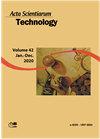Goldenberry powder processing: analysis by a response surface methodology
IF 0.6
4区 综合性期刊
Q3 MULTIDISCIPLINARY SCIENCES
引用次数: 1
Abstract
Goldenberry (Physalis peruviana) is a fruit of great interest for its nutritional properties and bioactive compounds, such as carotenoids. This study aimed to determine the ideal conditions for the development of a goldenberry powder. A Central Composite Design (CCD) was adopted to obtain response surfaces. For processing, different temperatures (50 - 70ºC) and times (27.18 - 32.82 hours) were used for dehydration of the fruits, evaluating the content of total carotenoids as a response and the moisture content around 15%. Data obtained were tested by analysis of variance (ANOVA) and fitted to a second-order polynomial equation using multiple regression analysis. An optimization study was carried out and the desirability function methodology was applied to find the ideal process condition. The optimization was determined at 52ºC and in a time of 27.18 hours, in which the experimental value obtained for total carotenoids was 12656.5 ± 527.22 mg 100 g-1 and moisture content of 15.00 ± 0.26%. In this condition, the global desirability value was 1.000 and the experimental values agreed with the predicted ones. Second-order polynomials were able to predict the carotenoids content in goldenberry powder, as well as the moisture content of the powder. The CCD and response surface tools were effective in optimizing the process. The production of goldenberry powder under these experimental conditions represents a viable alternative for adding value to the fruits, enabling the production of a potential food ingredient with carotenoid retention.金莓粉加工:响应面法分析
金莓(Physalis peruviana)是一种因其营养特性和生物活性化合物(如类胡萝卜素)而备受关注的水果。本研究旨在确定开发金莓粉的理想条件。采用中心复合设计(CCD)获得响应面。在加工过程中,采用不同的脱水温度(50 ~ 70℃)和时间(27.18 ~ 32.82 h)对果实进行脱水处理,以总类胡萝卜素含量为响应,水分含量在15%左右。所得数据采用方差分析(ANOVA)进行检验,并采用多元回归分析拟合二阶多项式方程。采用理想函数法对工艺条件进行了优化研究。优化温度为52℃,时间为27.18 h,得到的总类胡萝卜素的实验值为12656.5±527.22 mg 100 g-1,水分含量为15.00±0.26%。在此条件下,总体理想值为1.000,实验值与预测值一致。二阶多项式可以预测金莓粉中类胡萝卜素的含量,也可以预测金莓粉的水分含量。CCD和响应面工具可有效地优化工艺。在这些实验条件下生产金莓粉代表了增加水果价值的可行替代方案,使生产具有类胡萝卜素保留的潜在食品成分成为可能。
本文章由计算机程序翻译,如有差异,请以英文原文为准。
求助全文
约1分钟内获得全文
求助全文
来源期刊

Acta Scientiarum-technology
综合性期刊-综合性期刊
CiteScore
1.40
自引率
12.50%
发文量
60
审稿时长
6-12 weeks
期刊介绍:
The journal publishes original articles in all areas of Technology, including: Engineerings, Physics, Chemistry, Mathematics, Statistics, Geosciences and Computation Sciences.
To establish the public inscription of knowledge and its preservation; To publish results of research comprising ideas and new scientific suggestions; To publicize worldwide information and knowledge produced by the scientific community; To speech the process of scientific communication in Technology.
 求助内容:
求助内容: 应助结果提醒方式:
应助结果提醒方式:


